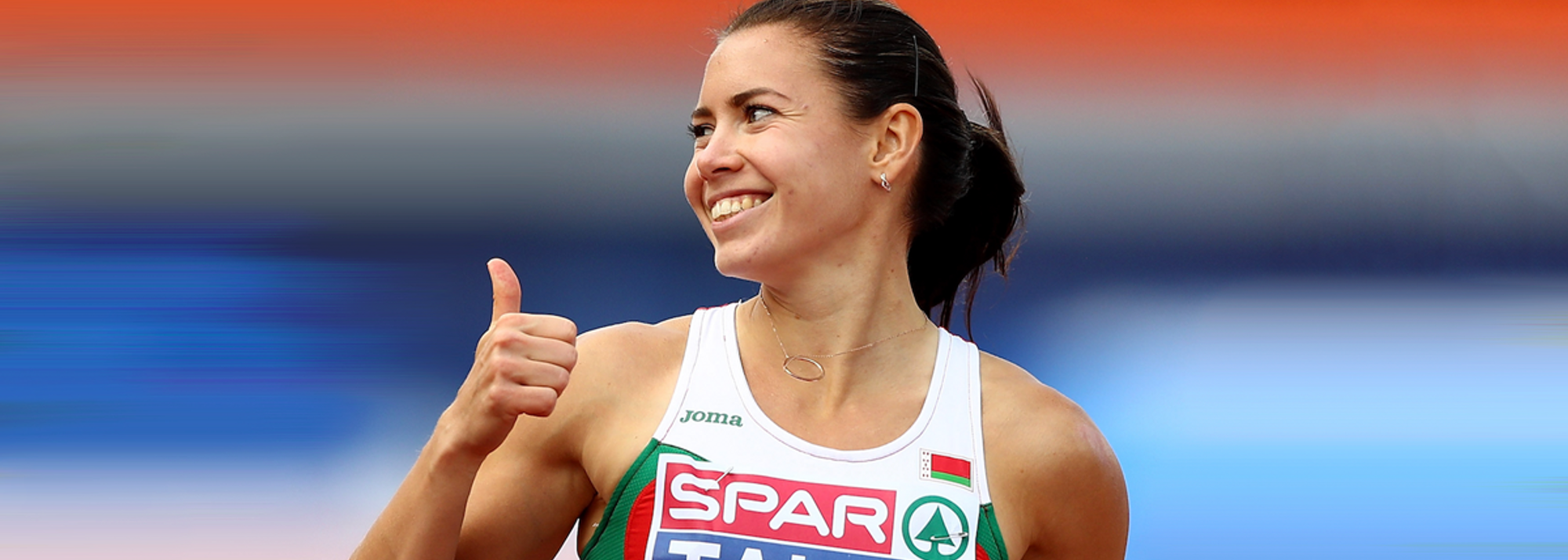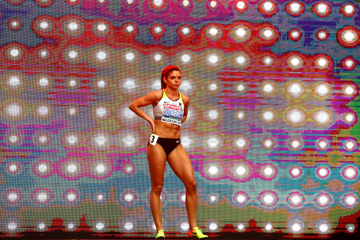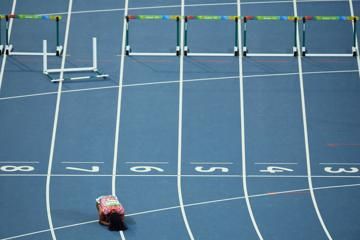Alina Talay celebrates at the European Championships in Amsterdam (© Getty Images)
Going it alone has helped Alina Talay reach a new level, but her quest for knowledge is a race that never ends.
In sport, as in life, the highest of high-achievers tend to possess a similar obsession with self-improvement, a kind of bottomless well of desire to know more, learn more, be more.
When Alina Talay picks up the phone, she’s sitting in a cafe in Minsk, Belarus, shortly after finishing a German lesson, a little re-education in languages the 29-year-old has been undertaking for the past month.
“My brain is exploding a little bit right now,” she says. “It’s German for beginners, and I’m doing it because I lived in Austria for two years and I couldn’t learn a lot so I feel ashamed, and I want to learn more.”
And when Talay chooses to soak up knowledge, she can switch her mind to sponge mode in an instant.
In athletics, it’s rare to find a world-class athlete willing – or able – to coach themselves, especially in an event as dizzyingly technical as the 100m hurdles.
But Talay has been around the world, worked with some of the biggest gurus in the sport, and all along the way she’d been watching, listening, learning – all so she could one day assume complete control of her career and steer it towards the top.
“It was not an easy decision,” said Talay. “But I have a lot of experience of various training systems. I trained in Austria so I saw mostly the German system, then I was in the [United] States for one and a half years where I was training at the IMG Academy in Florida, and after my not-so-good recent season, I said I’d try coaching myself and combine all the different systems.
“And,” she adds, “it kind of worked.”
Dream Run
Last month, in the space of one magical evening in St. Polten, Austria, Talay twice re-wrote her PB, first breezing through the heats in 12.61 then bounding away from European champion Cindy Roleder to obliterate that mark, her mind in utter disbelief as she saw the time: 12.41.
“I couldn’t believe my eyes, I thought it was not possible to run that fast,” she says. “I expected 12.6. It was crazy.”
Anyone wondering if Talay’s mark was legitimate had their answer in the weeks that followed when she proved it was anything but a fluke, Talay finishing second in Oslo in 12.63 then third in Stockholm in 12.55 before winning her national championships last weekend in 12.50, all with legal wind readings.
“I couldn’t believe [the 12.41] until last week, it’s just crazy, but when I ran [12.50] in Minsk I finally believed I’m ready to run really fast.”
The Creative Process
Think of the 100m hurdles as a work of art, a 12-ish-second piece of performance art – one that can be broken down scientifically with the methodical precision of an engineer.
In essence, Talay is everything when it comes to her career: subject, scientist and the architect of her destiny.
“Honestly, I have no idea how many hours I spend scrolling through the videos on my phone of exercises, runs, hurdling, everything,” she says. “It’s tricky because you need to film yourself, to see all the videos, to see the technique of how you’re doing things throughout the year and decide where your weakness is. It’s not easy for the mind and I get so tired from doing that.
“But it’s pretty cool because I know what I need to do, what is better for me. You’re the part of the creative process.”
But this is nothing new, and truth be told, Talay’s running education is almost two decades in the making.
Growing up in Orsha, a small city in the northeast of Belarus, Talay’s talent was spotted at the age of 13 by a school teacher who noticed her superior speed relative to those around her. She sprinted, hurdled and jumped in those early years, but a lower-back injury at the age of 15 forced her to abandon jumping.
Through her teens, athletics was nothing more than a hobby, but in 2008 she finished fourth at the IAAF World Junior Championships in Bydgoszcz, clocking 13.31 in the 100m hurdles final, and then she dared to dream.
“I thought maybe it can be my profession and I can earn some money from it, so from then I thought about it in a serious way,” she says.
Fork in the Road
In 2014 she came to a crossroads: beset by injury problems ahead of the European Championships in Zurich, Talay could only finish fifth in the final.
“I decided I had to do something new or quit because the injuries were making it not nice to train,” she says. “Then I moved to Austria and trained with a new coach and my career improved.”
She spent two years training under coach Phillipp Unfried and reached a new level, winning bronze at the 2015 World Championships in Beijing. “That was big for me to understand I could compete with the best of the world,” she says. “It convinced me to continue for five more years.”
That medal also bode well for the following year, but on the grandest stage of all in Rio, Talay’s Olympic dream went down in flames.
She lost her balance off the eighth barrier in the 100m hurdles semi-final and just about stayed on her feet over the last two, but after that she could only trail home last in 13.66.
“You can imagine,” she says. “For an athlete preparing for four years, then suddenly after 12 seconds you just suddenly have nothing, it was a big disappointment. I took a break for two months and did nothing, just forgot about track and then made a decision I needed to change something else.
“After that I moved to Florida to train with a new coach. I’m all about such crazy decisions; I know I need to do something else to achieve my dream so I just change it immediately.”
She spent a year and a half being coached by Loren Seagrave before returning home to prepare for the 2018 season, though despite being her own coach these days, she’s not alone by any means. Talay coaches, and trains with, a 21-year-old male hurdler at her base in Minsk, and when on training camps abroad she regularly coordinates with fellow European sprint hurdlers to train together.
“At the competition we’re rivals but in our daily lives we’re friends,” she says. “It’s cool to push each other and see what others do, what kind of technique they use and it’s helped me to train myself.”
Talay has also quietly been working on behalf of her peers as part of the IAAF Athletes Commission, which she had been involved with since 2016 before stepping aside in recent weeks due to family commitments. “It’s been two great years where we could really make our voices heard,” she says. “It was cool and I really hope in the future it will be even better. It would be really nice to see track and field among the most popular sports in the world because right now we’re changing.”
Berlin Bound
To date, Talay has won two European indoor gold medals, one world outdoor bronze, one world indoor bronze, and European outdoor gold and silver.
In August, she hopes to add to that collection at the European Championships in Berlin, the apex of her year.
“I want to be the best, like every athlete,” she says. “I’ll try to show my best and make a good show in Berlin.”
The journey there will likely take her through IAAF Diamond League meetings in Rabat and London, and in between Talay will be busy studying her phone, scanning those videos, looking for fractions, inches.
“Even in my best run, the 12.41, I can see a lot of mistakes,” she says. “Sometimes it’s a pain for my eyes to see my run. It’s like, ‘oh my God, what am I doing?’
"But it’s good, because I can improve in various parts and do even better.”
Words: Cathal Dennehy







